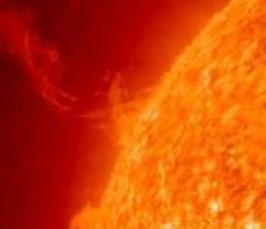ESP Online Seminar: Interactions between pre-existing and emerging magnetic flux systems observed with IRIS (S. Guglielmino)
ESPOS
- Datum: 03.05.2018
- Uhrzeit: 11:00 - 12:00
- Vortragende(r): Salvo Guglielmino
- Osservatorio Astrofisico di Catania
- Ort: Osservatorio Astrofisico di Catania (broadcasted at MPS)
- Raum: Auditorium
- Gastgeber: Andreas Lagg

We report multi-wavelength ultraviolet observations taken with the IRIS
satellite, concerning the emergence phase in the upper chromosphere and
transition region of an emerging flux region (EFR) embedded in the
unipolar plage of active region NOAA 12529. IRIS data are complemented
by full-disk, simultaneous observations of the Solar Dynamics
Observatory satellite, relevant to the photosphere and the corona. The
photospheric configuration of the EFR is also analysed by measurements
taken with the spectropolarimeter onboard the Hinode satellite, when the
EFR was fully developed. Recurrent intense brightenings that resemble UV
bursts, with counterparts in all coronal passbands, are identified at
the edges of the EFR. Jet activity is also found at chromospheric and
coronal levels, near the observed brightness enhancement sites. Analysis
of the IRIS line profiles reveals heating of dense plasma in the low
solar atmosphere and the driving of bi-directional, high-velocity flows
with speeds up to 100 km/s at the same locations. Comparing these
signatures with previous observations and numerical models, we suggest
evidence of several long-lasting, small-scale magnetic reconnection
episodes between the emerging bipole and the ambient field. This process
leads to the cancellation of a pre-existing photospheric flux
concentration of the plage with the opposite polarity flux patch of the
EFR. Moreover, the reconnection appears to occur higher in the
atmosphere than usually found in UV bursts, explaining the observed
coronal counterparts.